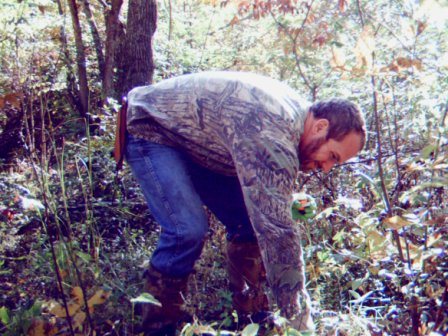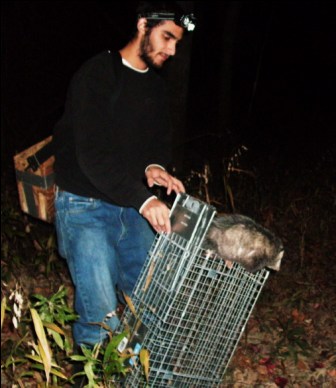Mammal
Abstracts 2009
The Effects of Muskrat (Ondatra zibethicus) Grazing on Species Richness and Dissolved Oxygen Content of Freshwater Aquatic Ecosystems
The Emergence Surveillance of Three Southeastern Myotis Roost Trees in the Clark's River Floodplain
Southeastern Myotis (Myotis austroriparius) are a species of special concern in the commonwealth of Kentucky. Little is understood of the ecology of this species in its northern, inland range. With the discovery of three maternity colonies in Marshall Co., KY, we were able to begin recording valuable data. Research began June of 2009. Using nightvision monoculars, evening emergence time and number of bats was recorded on a weekly basis from each roost beginning in September. M. austroriparius maternity colonies have highly variable emergence numbers, and seem to move from one roost to another on at least a weekly, random basis. Time of emergence is predictable, though variable by season. More research is needed to discern time and location of hibernation. Does Small Mammal Abundance and Species Diversity Differ Between Clark's River National Wildlife Refuge and Surrounding Private Lands? Santiago Martin and Caleb Roberts
Baited site selection of Canis latrans: commercial scent lures vs. carrion of Odocoileus virgnianus Troy Gerard and Erica Ludtke
 Trapping is often used to obtain statistical analysis on coyote populations and behavior. Analysis is often weakened or constrained as a result of inadequate sample size. Biologists often use easily obtained commercial lures to attract coyotes to trap sets and overlook the power and effectiveness of carrion as an attractant. Trapping is often used to obtain statistical analysis on coyote populations and behavior. Analysis is often weakened or constrained as a result of inadequate sample size. Biologists often use easily obtained commercial lures to attract coyotes to trap sets and overlook the power and effectiveness of carrion as an attractant.
 We compared the effectiveness of attracting coyotes by using commercial scent lures verse carrion of White-tailed deer. Five sites were chosen within an approximately one square kilometer area where coyotes have been readily observed in Graves County, Kentucky. A different lure (four chemically manufactured, one natural carrion) was used at each site for a one-week period and then rotated by random selection. Cameras were secured to trees near the lure to capture coyote activity in the area. The collected data were analyzed using chi-square statistical analysis. The calculated P-value was greater than the critical value, concluding that our alternative hypothesis, that deer carrion is more effective than commercial lures, was supported. We compared the effectiveness of attracting coyotes by using commercial scent lures verse carrion of White-tailed deer. Five sites were chosen within an approximately one square kilometer area where coyotes have been readily observed in Graves County, Kentucky. A different lure (four chemically manufactured, one natural carrion) was used at each site for a one-week period and then rotated by random selection. Cameras were secured to trees near the lure to capture coyote activity in the area. The collected data were analyzed using chi-square statistical analysis. The calculated P-value was greater than the critical value, concluding that our alternative hypothesis, that deer carrion is more effective than commercial lures, was supported. Herbivorous Feeding Strategies: A Presentation for Study in High Schools
Laura Francisco and Sara Thomason
 The use of interactive tools and visual instruction are teaching methods that are becoming increasingly common in schools. Studies have shown that students better comprehend what they are learning if they are challenged and asked to explain their views on a subject (Hatano and Inagaki 1987). However, many teaching techniques have emphasized the standard direct instruction, where the student is passively learning the material that is being taught (Campione, Brown and Connell 1988). In order to enhance the study of biology in high schools, our project was to create an educational PowerPoint® presentation that would allow students to learn more interactively and thus retain the information more readily. We focused our efforts on adaptations to specialized herbivorous feeding strategies; students will be able to understand the selective forces associated with feeding and be able to apply the same concept to other natural occurrences. After consulting the science curriculum for Calloway County, local high schools were contacted to determine what type of presentation would be most suitable for their classes. Our presentation, designed for the classes, asks questions based upon Benjamin Bloom’s six levels of thinking (Bloom, 1956). The presentation also contains videos of some of the mammalian adaptations to supplement a visual learning strategy. The presentation was sent to the schools with instructions on how it should be presented to the class.
The use of interactive tools and visual instruction are teaching methods that are becoming increasingly common in schools. Studies have shown that students better comprehend what they are learning if they are challenged and asked to explain their views on a subject (Hatano and Inagaki 1987). However, many teaching techniques have emphasized the standard direct instruction, where the student is passively learning the material that is being taught (Campione, Brown and Connell 1988). In order to enhance the study of biology in high schools, our project was to create an educational PowerPoint® presentation that would allow students to learn more interactively and thus retain the information more readily. We focused our efforts on adaptations to specialized herbivorous feeding strategies; students will be able to understand the selective forces associated with feeding and be able to apply the same concept to other natural occurrences. After consulting the science curriculum for Calloway County, local high schools were contacted to determine what type of presentation would be most suitable for their classes. Our presentation, designed for the classes, asks questions based upon Benjamin Bloom’s six levels of thinking (Bloom, 1956). The presentation also contains videos of some of the mammalian adaptations to supplement a visual learning strategy. The presentation was sent to the schools with instructions on how it should be presented to the class.
Improving Methods for Capturing Squirrels
Nick Cox and Rob Crouch  Squirrels are seen as pests by farmers because they feed on crops. Because of this, they wish to get them away from crops, but traditional live traps are not used because they are seen as useless and expensive since squirrels are hard to trap. Instead, rodenticides are used to kill squirrels. This can have negative consequences on the environment, so our project was to determine if squirrels can be trapped easier by placing live traps at the bases of common trees in the area. Our hypothesis is that setting traps at the base of common trees will help increase the trapping success. The null hypothesis is that the trapping success will remain very low. Twelve live traps were used for our experiment. They were baited with a squirrel mix and peanut butter, and checked every twelve hours. In the end, our trapping success was very low and progress on squirrel capturing was not made. Squirrels are seen as pests by farmers because they feed on crops. Because of this, they wish to get them away from crops, but traditional live traps are not used because they are seen as useless and expensive since squirrels are hard to trap. Instead, rodenticides are used to kill squirrels. This can have negative consequences on the environment, so our project was to determine if squirrels can be trapped easier by placing live traps at the bases of common trees in the area. Our hypothesis is that setting traps at the base of common trees will help increase the trapping success. The null hypothesis is that the trapping success will remain very low. Twelve live traps were used for our experiment. They were baited with a squirrel mix and peanut butter, and checked every twelve hours. In the end, our trapping success was very low and progress on squirrel capturing was not made. |



